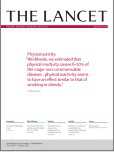The Lancet:揭示降低孕妇早产率的措施
2013-05-06 T.Shen 生物谷
2012年11月20日 --11月15日,刊登在国际杂志The Lancet上的一篇研究报告中,来自国外的研究者表示,截止到2015年,通过在39个国家(包括美国在内)实施降低孕妇早产率到5%,可以阻止大约58,000个早产儿的出生,早产率的降低有助于帮助各国降低数十亿美元的经济损失。 研究者Hannah表示,来自39个国家的政府和健康机构都需要进行必要的干预措施来帮助妇女进行优生优育,并且生出
2012年11月20日 --11月15日,刊登在国际杂志The Lancet上的一篇研究报告中,来自国外的研究者表示,截止到2015年,通过在39个国家(包括美国在内)实施降低孕妇早产率到5%,可以阻止大约58,000个早产儿的出生,早产率的降低有助于帮助各国降低数十亿美元的经济损失。
研究者Hannah表示,来自39个国家的政府和健康机构都需要进行必要的干预措施来帮助妇女进行优生优育,并且生出健康的婴儿。当前美国的早产率正在逐渐下降,早产率对于高资源国家的经济发展非常关键,因此控制孕妇的早产率非常重要。
在文章中,研究者提出了5种证明有效的干预措施,当这些措施结合施用的话,将会使得39个国家婴儿的早产率从9.6%降低至9.1%,可以帮助政府挽回30亿的经济和健康损失。
其中5项干预措施包括:1)消除早期的剖腹产手术,如果必要将进行引产手术;2)在辅助生殖技术期间降低多种胚胎移植;3)帮助妇女戒烟;4)提供孕酮补充物给高危孕妇;5)对于子宫颈短的高危妇女进行宫颈环扎术。
研究者表示,目前将早产率降低至5%是完全可行的,继续对引发早产因素的研究将帮助研究者更大程度地降低早产婴儿的比例。
早产是导致新生儿死亡的主要原因,而且即便是早产生存下来的婴儿在未来的生活中夜面临着很多潜在的健康问题,包括呼吸问题、脑性瘫痪以及智力和运动障碍及其它病症。
与早产相关的拓展阅读:

Background Every year, 1·1 million babies die from prematurity, and many survivors are disabled. Worldwide, 15 million babies are born preterm (<37 weeks' gestation), with two decades of increasing rates in almost all countries with reliable data. The understanding of drivers and potential benefit of preventive interventions for preterm births is poor. We examined trends and estimate the potential reduction in preterm births for countries with very high human development index (VHHDI) if present evidence-based interventions were widely implemented. This analysis is to inform a rate reduction target for Born Too Soon. Methods Countries were assessed for inclusion based on availability and quality of preterm prevalence data (2000—10), and trend analyses with projections undertaken. We analysed drivers of rate increases in the USA, 1989—2004. For 39 countries with VHHDI with more than 10 000 births, we did country-by-country analyses based on target population, incremental coverage increase, and intervention efficacy. We estimated cost savings on the basis of reported costs for preterm care in the USA adjusted using World Bank purchasing power parity. Findings From 2010, even if all countries with VHHDI achieved annual preterm birth rate reductions of the best performers for 1990—2010 (Estonia and Croatia), 2000—10 (Sweden and Netherlands), or 2005—10 (Lithuania, Estonia), rates would experience a relative reduction of less than 5% by 2015 on average across the 39 countries. Our analysis of preterm birth rise 1989—2004 in USA suggests half the change is unexplained, but important drivers include non-medically indicated labour induction and caesarean delivery and assisted reproductive technologies. For all 39 countries with VHHDI, five interventions modelling at high coverage predicted a 5% relative reduction of preterm birth rate from 9·59% to 9·07% of livebirths: smoking cessation (0·01 rate reduction), decreasing multiple embryo transfers during assisted reproductive technologies (0·06), cervical cerclage (0·15), progesterone supplementation (0·01), and reduction of non-medically indicated labour induction or caesarean delivery (0·29). These findings translate to roughly 58 000 preterm births averted and total annual economic cost savings of about US$3 billion. Interpretation We recommend a conservative target of a relative reduction in preterm birth rates of 5% by 2015. Our findings highlight the urgent need for research into underlying mechanisms of preterm births, and development of innovative interventions. Furthermore, the highest preterm birth rates occur in low-income settings where the causes of prematurity might differ and have simpler solutions such as birth spacing and treatment of infections in pregnancy than in high-income countries. Urgent focus on these settings is also crucial to reduce preterm births worldwide. Funding March of Dimes, USA, Eunice Kennedy Shriver National Institute of Child Health and Human Development, and National Institutes of Health, USA.
本网站所有内容来源注明为“梅斯医学”或“MedSci原创”的文字、图片和音视频资料,版权均属于梅斯医学所有。非经授权,任何媒体、网站或个人不得转载,授权转载时须注明来源为“梅斯医学”。其它来源的文章系转载文章,或“梅斯号”自媒体发布的文章,仅系出于传递更多信息之目的,本站仅负责审核内容合规,其内容不代表本站立场,本站不负责内容的准确性和版权。如果存在侵权、或不希望被转载的媒体或个人可与我们联系,我们将立即进行删除处理。
在此留言













#Lancet#
40